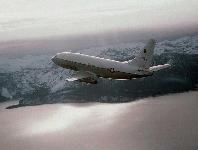
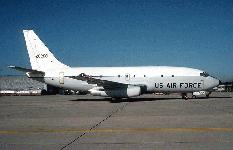

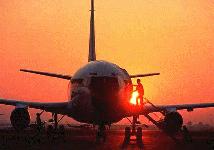
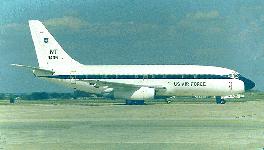
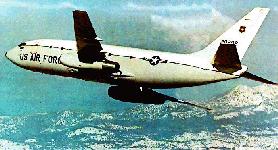



The T-43A is a medium-range, swept-wing jet aircraft. Equipped with modern navigation and communications equipment to train navigators for strategic and tactical aircraft, the T-43A is primarily used in the Air Force's undergraduate navigator training program. Several T-43s are configured for passengers and provide operational support to assigned commands and the Air National Guard.
The T-43A is the Air Force version of the Boeing 737 transport. One jet engine is mounted under each wing. The exterior differences between the military and commercial aircraft include the addition of many small blade-type antennas, sextant ports, a wire antenna for high-frequency radio and fewer windows.
The aircraft has considerably more training capability than the plane it replaced, the T-29C. Inside each T-43A training compartment are two minimum proficiency, two maxiumum proficiency and 12 student stations. Two stations form a console, and instructors can move their seats to the consoles and sit beside students for individual instruction. The large cabin allows easy access to seating and storage, yet reduces the distance between student stations and instructor positions.
The student training compartment is equipped with advanced avionics gear identical to that of Air Force operational aircraft. This includes mapping radar; VOR (VHF omnirange) and TACAN (tactical air navigation) radio systems; inertial navigation system; radar altimeter; and all required communications equipment. Five periscopic sextants spaced along the length of the training compartment are used for celestial navigation training.
The majority of the T-43A trainers are used for navigator training at Randolph Air Force Base, Texas, where the Air Force also trains Air National Guard, Air Force Reserve, U.S. Navy, U.S. Marine and international students. The remaining planes are assigned to the Air National Guard at Buckley Air National Guard Base, Colo., where they are used for the U.S. Air Force Academy's airmanship program and to provide travel service for academy sports teams. In addition, U.S. Southern Command has a CT-43 used for commander transport.
The first T-43A was delivered to the Air Force at Mather Air Force Base, Calif., in September 1973. The last deliveries were made in July 1974. Air Education and Training Command's T-43 fleet relocated to Randolph Air Force Base, Texas, in May, 1993, due to the closure of Mather AFB.
Specifications | |
| Primary Function | Navigator trainer |
| Builder | Boeing Co. |
| Power Plant | Two Pratt & Whitney JT8D-9A engines |
| Thrust | 14,500 pounds (6,525 kilograms) each engine |
| Length | 100 feet (30.3 meters) |
| Height | 37 feet (11.2 meters) |
| Maximum Takeoff Weight | 115,000 pounds (67,500 kilograms) |
| Wingspan | 93 feet (28.2 meters) |
| Speed | 535 mph (Mach 0.72) at 35,000 feet |
| Ceiling | 37,000 feet (11,212 meters) |
| Range | 2,995 miles (2,604 nautical miles) |
| Armament | None |
| Crew | 12 navigator students, six instructor navigators, pilot and co-pilot |
| Date Deployed | September 1973 |
| Unit Cost | $5,390,000 |
| Inventory | Active force, 13; ANG, 2; Reserve, 0 |





